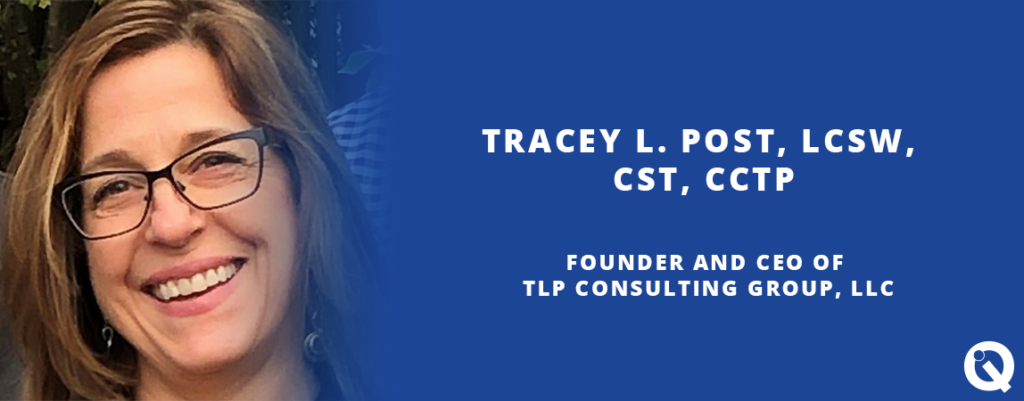Tracey L. Post, LCSW, CST, CCTP, is the Founder and CEO of TLP Consulting Group, which offers training and consultations to small and large businesses. TLP also houses the Princeton Center for MindBody Healing, which provides evidenced-based trauma and relationship counseling. Tracey was recently featured in our Quality Institute webinar, Anxiety vs. Resiliency: How to Manage One While Building the Other During the COVID-19 Crisis, which is available here.
Many of us are working in different environments and experiencing more stress as a result of COVID-19 and social distancing. What are the indicators that let us know that we’re under stress?
We each have our own blueprint of stress factors and I think that the areas we can look at fall into four main categories, which are physical, emotional, interpersonal, and relational. Physical symptoms show up in ways, such as headaches, stomachaches, nagging shoulder pain, fatigue, sleep disturbances, and other similar symptoms. Recognizing these physical signs is really important. The following category, emotional, expresses itself with feelings like anxiety, anger, feeling sad, helpless, or depressed and can happen simultaneously with physical signs of stress. Now, interpersonal signs can show up in many different ways. For example, when you come home and snap at your dog, partner, or someone else, instead of just saying, “I’m so sad about what’s happening in the world.” Finally, relational signs of stress can come about in ways, such as self-isolating because it’s overwhelming to engage with people when our resources are so low., or you might see procrastination or distancing from colleagues while on the job. What we need to do is physically distance — not socially distance.
What are some best practices to reduce stress during this time?
One universal technique that can work for everyone is called the reset breath. When we’re starting to get stressed out, we start to breathe faster. Our heart rate goes up, preparing for fight, flight, or freeze. And this breath-reset reverses that. Think: four, one, five. Four seconds to breath in, hold for one second, then exhale for five seconds or more. Another valuable technique is called the Butterfly Hug for Bilateral Stimulation. Cross your hands and put your fingers on your collarbones, and then flutter your fingers. The technique connects the left and right brain and calms the breathing and the brain down.
What are the coping mechanisms that I use? I might have extra glass of wine every night and that might be fine for right now. But I also want to diversify and make sure that I’m walking, I’m talking to friends, or I’m doing some stretching. I think that the most important technique is the one that works for you. For some people, it’s listening to music, meditation, or yoga.
In a work environment, how do you create a culture of resilience and self-care?
I would think about the five basic principles of a trauma-informed agency: safety, trust, choice, collaboration, and empowerment. A trauma-informed agency in a nutshell is an organization whose mission is altered by virtue of its understanding of trauma and how it impacts consumers and ourselves. Trauma-informed agencies ask, “What has happened to you and how can I assist?” They don’t ask, “What is wrong with you?”
The acronym I developed is PEACE, which stands for: Provide Information, Educate, Acknowledge Emotions, Create Space for Practice, and Example; as in, setting an example of self care for all staff. It’s crucial for us to feel safe and to allow folks to make decisions about best practices. Providing information is important and you need to acknowledge that everyone’s feelings are okay. You also want to create a space for people to practice self-care; like maybe sending a text reminding people to practice breathing techniques. And modeling as an individual is important: Be an example as a parent or a boss; don’t just tell your children or employees what to do.
What can we do to help coworkers and family members who are struggling to cope with new stressors?
Acknowledge and validate other people’s feelings. Reach out. Connect by phone or other communication technologies. If someone keeps saying that they are fine, maybe you can express how the stress is manifesting for you and what you are doing to cope better. Modeling self-care is critical.
What kind of language should be used to reassure children who are worried about what’s happening?
It’s like in the airplane; you have to put your own oxygen mask on first and then you take care of your children. People take in more information from our body language than from actual words. So, breathe, act in a calm manner, and create space for conversation. Keep the dialogue going; it’s not a one-shot conversation. I also suggest limiting screen time and offer other distractions.
For kids, especially, we want to ask what they already know and what it means for them. Kids may not understand what social distancing means. They may say they do, but when you ask them what it means, you may get a different story. Practice self-care together. Maybe try breathing together. As humans, we all need to release our stress or it will live inside of us everyday.

